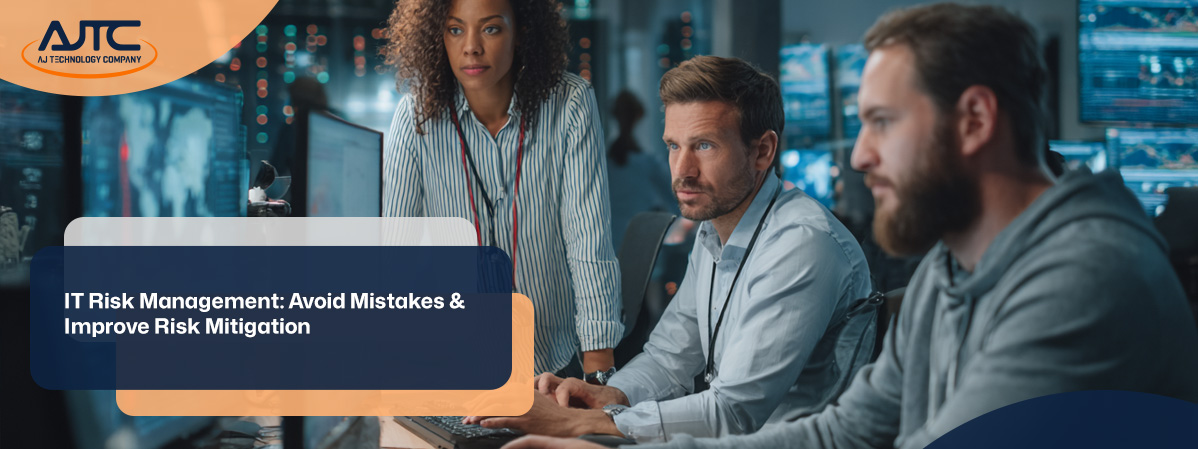.webp)
Chief Executive Officer

IT risk management is no longer optional—it's a business necessity. As technology becomes more central to operations, the risks tied to it grow more complex. In this blog, you'll learn what IT risk management is, why it matters, and how to build a strong program. We'll also cover common mistakes, key benefits, and best practices to help you protect your organization from potential threats. Topics like vulnerability, cybersecurity, risk mitigation, and enterprise risk will also be explored.
IT risk management is the process of identifying, evaluating, and addressing risks related to your technology systems. These risks can include data breaches, system failures, or unauthorized access to sensitive information. The goal is to reduce the chance of these events happening and to limit the damage if they do.
A solid risk management program helps you stay compliant with regulations, avoid financial losses, and maintain customer trust. It also supports business continuity by preparing your organization to respond quickly to incidents. By understanding your risk profile, you can make smarter decisions about where to invest in security and how to prioritize your efforts.

Even well-meaning organizations can fall into traps when managing IT risks. Here are some of the most common issues that can weaken your strategy.
Skipping a structured framework leads to inconsistent processes. Frameworks like the NIST Cybersecurity Framework offer a clear path to follow, making it easier to align your efforts with industry standards.
Some companies treat risk management as a checkbox activity. But without regular updates and reviews, your plan can quickly become outdated and ineffective.
A proper IT risk assessment helps you understand where your vulnerabilities lie. Without it, you may miss critical gaps that attackers can exploit.
Failing to patch software or update systems leaves you open to attacks. Vulnerability management should be a regular part of your operations.
Best practices exist for a reason—they're proven to work. Ignoring them can lead to poor decision-making and increased exposure.
A one-time effort won't cut it. You need an ongoing program that evolves with your business and the threat landscape.
Having no plan—or a vague one—can delay your response during a crisis. Strong mitigation strategies help reduce impact and speed up recovery.
A well-executed IT risk management plan offers several advantages:

Enterprise risk includes all types of risks a business faces, from financial to operational. IT risk is a major part of this because most business functions depend on technology. If your IT systems fail, it can affect everything from customer service to revenue.
Integrating IT risk into your broader enterprise risk management strategy ensures that technology-related threats are not treated in isolation. This approach helps you manage risk more effectively across all departments and align your efforts with business goals.
Managing IT risk isn’t a one-time task. It’s a continuous process that involves planning, monitoring, and adjusting. Here are the key steps to follow.
Start by outlining how you’ll identify, evaluate, and respond to risks. This process should be documented and shared with relevant teams.
Look at all the ways your data and systems could be compromised. This includes internal threats, external attackers, and system failures.
Assess the likelihood and impact of each risk. Use this information to prioritize which ones need immediate attention.
Use software and frameworks to track and manage risks across the organization. These tools help you stay organized and consistent.
Your risk profile changes as your business grows or adopts new technology. Review it regularly to stay current.
Install firewalls, encryption, and access controls to protect your systems. These security controls are your first line of defense.
Make sure all stakeholders understand the risks and their roles in managing them. Clear communication builds accountability.

To put your IT risk management plan into action, start by assigning roles and responsibilities. Make sure each team member knows what they’re accountable for. Use a risk register to document identified risks, their status, and mitigation plans.
Next, schedule regular reviews of your risk management activities. This helps you catch new threats early and adjust your strategy as needed. Also, test your response plans through simulations or tabletop exercises. These drills prepare your team for real-world incidents.
Following proven methods can help you maintain a strong IT risk management posture over time:
Sticking to these practices helps organizations stay prepared and resilient.

Are you a business with over 10 employees looking to improve your IT risk management strategy? As your company grows, so do the risks tied to your technology systems. You need a plan that scales with your operations and keeps your data safe.
At AJTC, we help organizations build and maintain effective risk management programs. Our team works with you to assess your current posture, identify potential risks, and implement safeguards that align with your goals. Ready to take control of your IT risks? Contact us today.
Risk management helps organizations identify and reduce security risk by focusing on the most critical threats. It ensures that resources are used where they matter most. This approach supports effective risk management by aligning security efforts with business priorities.
It also helps organizations meet compliance standards and avoid penalties. By using a structured risk management framework, you can better protect your information system and maintain trust with stakeholders.
You should perform a risk assessment at least once a year or whenever there are major changes to your systems. Regular assessments help you stay ahead of new threats.
They also support risk identification and allow you to update your risk register with current information. This process is key to maintaining a strong security posture and avoiding costly security incidents.
A vulnerability is a weakness in your systems that attackers can exploit. These could be outdated software, weak passwords, or unsecured networks.
Addressing vulnerabilities through vulnerability management helps reduce your overall risk. It also supports mitigation efforts and strengthens your information security risk defenses.
A risk management program helps you manage risk as your business scales. Without it, you may overlook key threats that could disrupt operations.
It also supports organizational planning by aligning risk mitigation with business goals. A strong program helps safeguard your technology risk areas and supports long-term success.
To assess enterprise risk, start by identifying all technology-related threats that could impact your business. This includes internal and external risks.
Use tools and frameworks to evaluate each risk’s likelihood and impact. This helps prioritize mitigation efforts and supports enterprise risk management planning.
Risk communication ensures that everyone understands the risks and their role in managing them. It builds a culture of accountability and awareness.
Clear communication also helps with stakeholder engagement and supports risk monitoring. When everyone is informed, your organization can respond faster and more effectively.